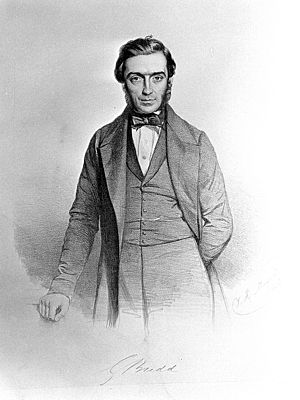George Budd facts for kids
George Budd (born February 23, 1808 – died March 14, 1882) was an important English doctor, writer, and teacher. He made big contributions to understanding diseases, especially those of the liver and stomach.
Contents
Early Life and Education
George Budd was born in a town called North Tawton in Devon, England, on February 23, 1808. He was the third son in his family. His father, Samuel Budd, was also a surgeon, which is a type of doctor who performs operations. George and six of his brothers all decided to become doctors, following in their father's footsteps.
He studied at home first. Then, in 1827, he went to St John's College at Cambridge University. Later, he moved to another college there called Caius College. After finishing his degree in 1831, he became a "fellow" of Caius College. This meant he was a senior member of the college, often involved in teaching or research. He was also a "third wrangler," which means he was one of the top three students in mathematics in his year.
Medical Career and Discoveries
After Cambridge, George Budd continued his medical studies in Paris, France, and at the Middlesex Hospital in London. In 1836, he was chosen to be a Fellow of the Royal Society. This is a very old and respected group of scientists in the United Kingdom.
In 1837, even before he had his full medical doctor (M.D.) degree, he became a doctor on the Dreadnought. This was a special hospital ship for sailors, located in Greenwich. On this ship, he worked with another doctor named George Busk. They studied diseases like cholera and scurvy, and also learned a lot about how the stomach and liver work.
By 1840, George Budd had earned his M.D. degree from Cambridge. He was then chosen to be a professor of medicine at King's College London. A year later, in 1841, he became a fellow of the Royal College of Physicians. This is a professional body for doctors in the UK. He also served as a "censor" for the college from 1845 to 1847, which meant he helped make sure doctors followed good medical practices.
Later Life and Retirement
In 1863, George Budd decided to retire from his teaching job at King's College. They made him an honorary fellow, which is a special title. By 1867, his health was not very good, so he stopped working as a doctor in London. He moved to Barnstaple to live a quieter life.
In 1880, he was again made an honorary fellow of Caius College, Cambridge. He had stopped being a regular fellow many years before when he got married. George Budd passed away on March 14, 1882, when he was 74 years old.
Key Medical Works
George Budd first became well-known for his writings about the stethoscope. This is the instrument doctors use to listen to sounds inside the body. He wrote about it in the Medical Gazette in 1837.
His most famous book was Diseases of the Liver, published in 1845. This book organized all the important information about liver diseases that doctors knew at the time. In this book, he described a liver condition that is now called Budd–Chiari syndrome. Another doctor, Carl von Rokitansky, had also noticed this condition in 1842. George Budd later wrote another important book called Diseases of the Stomach in 1855.
He also wrote reports about cholera cases on the Dreadnought hospital ship. These reports, written with George Busk, became important guides for understanding cholera. He also wrote about scurvy for a medical book series called Library of Practical Medicine.
George Budd published many articles and lectures in medical journals, especially the Medical Gazette. These included special talks he gave to other doctors, like his Gulstonian Lectures in 1843 and his Croonian Lectures in 1847 at the College of Physicians.


